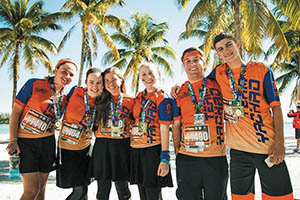
As the January 24 race approaches, hundreds of members of Team Yachad across North America and in Israel are in intensive training for the Miami Marathon and Half Marathon. Once again this year, Jasmine Graham, owner of Pace for Success and Fit Factory NYC, will be the trainer of Team Yachad Miami.
Jasmine is a fitness entrepreneur, experienced coach, fitness expert and endurance athlete. She is a RRCA-certified running coach and ACE-certified trainer and also holds certifications in Kettlebells, Tabata Bootcamp and TRX Suspension training.
“My goal is to UNLEASH your inner athlete,” she says.
Jasmine will “absolutely” be at the race. “That’s the best part,” she declares. “The coaches and I will go to Miami and support the team on the course. We are with participants for the entire race weekend.”
“Running and run/walking an endurance event is a great way to get into shape, lose unwanted pounds and increase your cardiovascular capacity,” Jasmine declares. “Here are a few tips to get you started on your half marathon journey.”
• Go to a reputable running store and get a gait analysis to ensure that you’re running in the right sneaker for your body. Running in the wrong sneakers could cause injury to knees, hips, shins, etc.
• Purchase wicking clothing such as Nike Dri-FIT so that you won’t chafe during your runs, allowing you to be most comfortable. Cotton is not your friend as it absorbs moisture.
• Join a running group, team or charity team, or get a friend or family member to join you as you train so that you have accountability.
• Pick three days a week you can commit to running so you build a base. One day is a long run, one day is a recovery run and one day is for speed work, tempo run and hill training. Four days of running is perfect but if you are pressed for time, three days will suffice. Never increase your weekly mileage by more than 10 percent per week. It’s about great runs followed by stretching and rolling out with foam roller immediately following. This prevents injury. Dynamic movements are done before your runs — high knees, skips, side shuffles, butt kicks and burpees.
• Pick at least one day for strength training. This can be with a personal trainer, boot camp, cross fit, calisthenics or any activity that will strengthen your core. A strong core will make you a stronger and faster runner. Two days a week of strength training would be optimal but one is better than none.
• If you are prone to injuries, add cross training to your routine, such as swimming, cycling, row machine or the elliptical. This helps build endurance with minimal resistance.
• Be sure to have a training calendar so that you don’t over train. New runners especially tend to run too much. The human body is amazing and it will adapt quickly to your training routine. Whether you have a coach, a group or an app, follow the program.
• Running inside is okay if you can’t get out, but your race is outdoors so get as much training outdoors as you can. If you run in a park, reverse direction every week to prevent overuse injuries. If you run on the same surface in the same direction your body gets accustomed to any irregularities in the road. For example, if the road curves a certain way you are putting excessive pressure on your right or left leg. Doing that constantly can cause an overuse injury like IT band syndrome or posterior tibial tendonitis. It’s best to reverse direction if, for example, you run in a park.
• Be sure to do speed workouts, and tempo runs to activate fast twitch muscles. Running at the same pace for every run is not good; it leads to overuse injuries. Your calendars will outline this.
• If you can, do a 5k or 10k during training. It’s a great race experience.
• When you run, land mid-foot and move to forefoot. Push the ground away with every step, run tall and lean forward from ankles, not hips. When walking, you should land closer to the heel and move to forefoot. In both cases your arms are at 90 degrees, shoulders rotate back and forth, look straight ahead, and push the ground away with every step.
• HYDRATE… HYDRATE… HYDRATE. Drink water, sports beverages and coconut water every week to replace electrolytes lost from sweating. Also figure out nutrition during runs. You need to take in at least 200 calories mixed with sodium and potassium every 40-45 minutes during your run. Your body needs this, no question about it.
• Get proper sleep every night.
Good luck. You are running for a marvelous cause—Yachad, and its mission to promote inclusion. Feel free to be in touch with me at coach@teamyachad.com.
See you in Miami in January!
By Jasmine Graham










